| Columns Retired Columns & Blogs |
Direct Acoustics Silent Speaker II Measurements
Sidebar 2: Measurements
The Silent Speaker's electrical impedance and phase are shown in fig.1. The impedance magnitude drops below 6 ohms only between 100 and 200Hz and in the low treble, with a minimum value of 5 ohms between 120 and 160Hz. This will be an easy speaker for the partnering amplifier to drive. The twin impedance peaks in the bass in fig.1 indicate that the Silent Speaker II is a reflex design, with the large rectangular port at the base of the front panel tuned to 42Hz. There are several wrinkles between 200 and 300Hz in the impedance traces, suggesting the presence of cabinet resonances of some kind. I investigated the enclosure panels' vibrational behavior with a simple plastic-tape accelerometer, which indeed detected very strong resonances at 211 and 277Hz (fig.2).
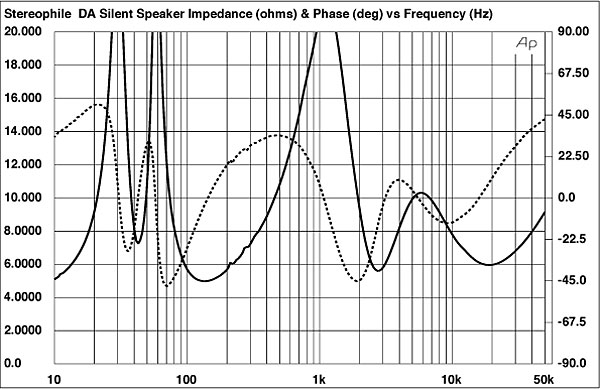
Fig.1 Direct Acoustics Silent Speaker II, electrical impedance (solid) and phase (dashed). (2 ohms/vertical div.)
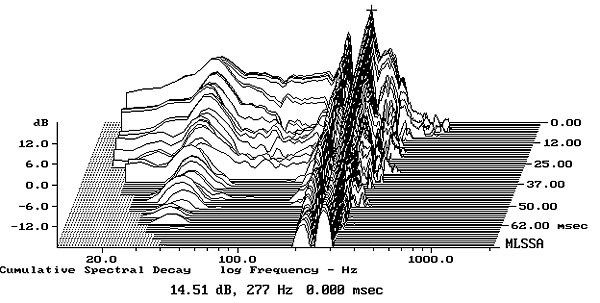
Fig.2 Direct Acoustics Silent Speaker II, cumulative spectral-decay plot calculated from output of accelerometer fastened to center of front panel (MLS driving voltage to speaker, 7.55V; measurement bandwidth, 2kHz).
Turning to the acoustic measurements, I measured the Silent Speaker II's frequency response in the farfield with DRA Labs' MLSSA system and a calibrated DPA 4006 microphone. For the nearfield and room responses I used an Earthworks QTC-40. The first problem was choosing the axis on which to measure the response. With the Silent's unusual drive-unit array—a 1" soft-dome tweeter and a 6.5" cone woofer side by side on the speaker's angled top panel—choosing a point in space at which to position the measuring microphone was somewhat arbitrary. Although the tweeter is just 25" from the floor and thus will be below the ears of a typical seated listener, measuring on an axis level with the tweeter would be readily repeatable. I performed all the measurements with the grille in place, as this is how JM auditioned the speaker.
The voltage sensitivity on this axis was low, at an estimated 83dB(B)/2.83V/m. The black trace above 300Hz in fig.3 shows the farfield response averaged across a 30° horizontal window centered on an axis level with the tweeter. There is very little output above 12kHz and the octave below that frequency is shelved down, correlating with JM's finding the speaker's balance to be on the warm side. There are some sharp suckouts between 800 and 3200Hz. I'm not sure what these are due to, but the crossover frequency is set at 1600Hz. Lower in frequency, the blue trace is of the output of the woofer, measured in the nearfield. It shows the expected minimum-motion point at 42Hz typical of a reflex design, and the port's output (red trace) peaks in the same region.
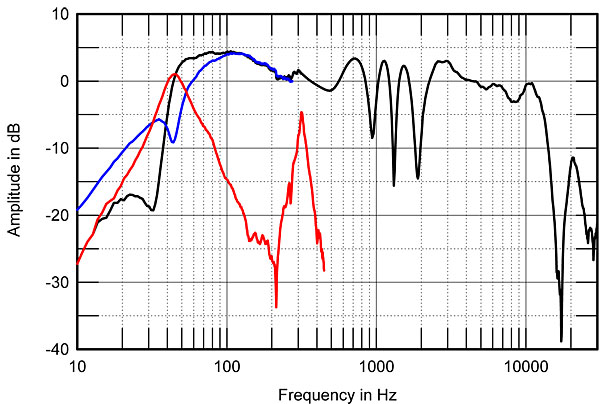
Fig.3 Direct Acoustics Silent Speaker II, anechoic response on horizontal axis at 50", averaged across 30° horizontal window and corrected for microphone response, with nearfield woofer (blue trace) and port (red) responses and their complex sum (black), plotted below 300, 450, and 300Hz, respectively.
However, the summed response of the woofer and port, taking into account acoustic phase and scaling the individual outputs in the ratio of the square root of their radiating areas (shown as the black trace below 300Hz in fig.3), has a notch at 32Hz. This suggests that the port has some of the behavior of a transmission line, and that its output is not completely in opposite polarity to that of the woofer until a frequency somewhat lower than the port tuning frequency. The port has a vicious peak in its output at 312Hz, which is probably and not coincidentally the frequency of a small peak in the cabinet vibrational plot (fig.2). The rise in woofer and overall response between 50 and 200Hz in fig.3 will be due to the nearfield measurement technique; the Silent Speaker II's low-frequency anechoic output will be flat down to below 50Hz.
The Silent Speaker II's lateral dispersion is shown in fig.4; the suckouts in the on-axis response fill in to the speaker's sides, more so to the front of this graph, which is on the woofer side of the baffle, which will tend to give the room's reverberant field a more neutral character when the woofers are placed on the outside edges of the mirror-imaged pair. Overall, the horizontal radiation pattern is more even than I was expecting, considering the drive-unit layout. In the vertical plane (not shown), the suckouts tend to fill in above the horizontal axis, and the region above 10kHz rises as you get closer to the actual tweeter axis.
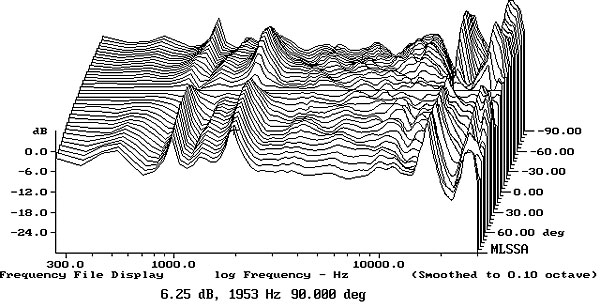
Fig.4 Direct Acoustics Silent Speaker II, lateral response family at 50", normalized to response on horizontal axis, from back to front: differences in response 90–5° off axis on tweeter side, reference response, differences in response 5–90° off axis on woofer side.
In the time domain, the Silent Speaker's step response (fig.5) suggests that the tweeter is connected in positive polarity, the woofer in inverted polarity, though their individual steps blend smoothly. However, multiple arrivals are evident during the decay of the woofer's step that correlate with the delayed energy evident in the waterfall plot in the region of the on-axis frequency-response suckouts (fig.6). The decay is very clean in the region covered by the tweeter, however.
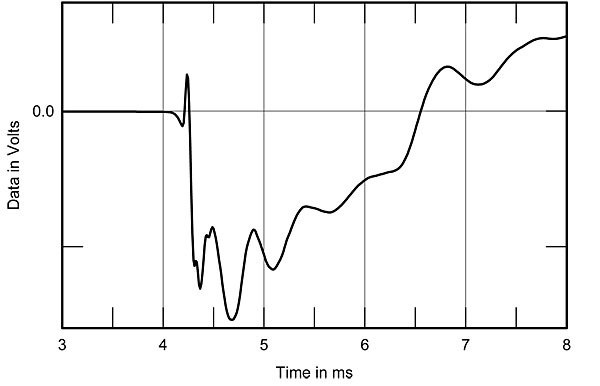
Fig.5 Direct Acoustics Silent Speaker II, step response on horizontal axis at 50" (5ms time window, 30kHz bandwidth).
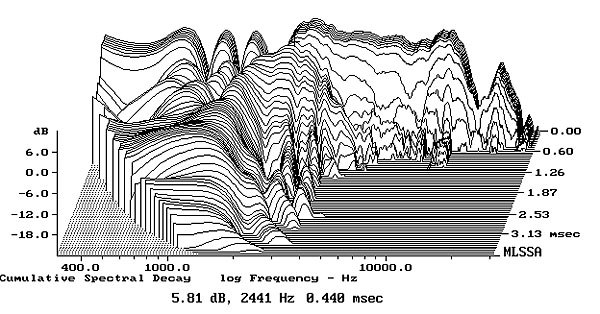
Fig.6 Direct Acoustics Silent Speaker II, cumulative spectral-decay plot on horizontal axis at 50" (0.15ms risetime).
The red trace in fig.7 shows the spatially averaged response of the Silent Speaker IIs in my listening room. The speakers were about 24" from their respective sidewalls and 72" from the wall behind them. They were toed-in to the listening position and their tweeters were on their inside edges, which is both how JM auditioned the speakers and how the dispersion measurements suggest they should perform best. The blue trace is the spatially averaged response of my longtime reference speakers, a 1978 pair of Rogers LS3/5as. Other than an excess of energy in the mid-treble, the Silent Speaker's in-room response between 200Hz and 2kHz is commendably even. The Direct Acoustics speaker has less energy in-room above 4kHz than the BBC minimonitor, which ties in with its warm balance. The Silent Speaker II also excites my room's 63Hz mode far more than does the LS3/5a.
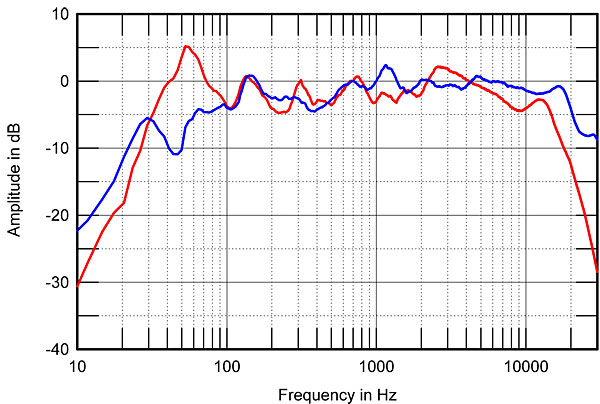
Fig.7 Direct Acoustics Silent Speaker II, spatially averaged, 1/6-octave response in JA's listening room (red trace); and of BBC LS3/5a (blue).
I listened to the Silent Speaker after performing and analyzing the measurements, so my expectations were not very high. However, I was pleasantly surprised when I set them up in my room and drove them with a pair of MBL 9007 monoblock amplifiers and my Mac mini feeding a dCS Debussy DAC via asynchronous USB. Other than the mellow highs, the balance was considerably more neutral and uncolored than I'd expected.
Eric Whitacre's Lux Aurumque, from the Dale Warland Singers disc of that title (CD, Gothic 49252), was reproduced with a warm, rich acoustic, the images of the singers floating above the plane of the speakers and the tonal balanced relatively uncolored. In Beethoven's complete cello sonatas, as performed by cellist Miklós Perényi and pianist András Schiff, our "Recording of the Month" for January 2005 (CD, ECM New Series 1819/20), the sound of both instruments was rich, appealing, and uncolored. Even though I knew there were high-level cabinet and port resonances present, and even though I could hear the former with a stethoscope and the chromatic tone-burst scales on Editor's Choice (CD, Stereophile STPH015-2), they didn't seem to be particularly audible at the listening position with music. However, Richard Lehnert's speaking voice on Editor's Choice did sound a bit "hooty."
Pink noise sounded evenly balanced when my ears were a few inches above the horizontal axis. However, the midbass was grumbly and a little disconnected-sounding. And when I stood up the Silent Speaker II's balance sounded hollow, with too much treble.
Rock music didn't fare as well as classical with these speakers. That mid-treble excess in-room was not kind to aggressively recorded tracks, such as the title song of Paul Simon's So Beautiful or So What (CD, Hear Music HRM-32814). This has a closely recorded electric-guitar ostinato with a one-in-the-bar bass drum, and through the Silent Speakers it just came across as overcooked. When I listened to the 1/3-octave warble tones on Editor's Choice, the bass was weighty down to the 40Hz band, a little suppressed at 32Hz, and gone by 25Hz. But the quality of the bass was not as well defined as I would wish. While the double bass in "Through the Morning, Through the Night," from Alison Krauss and Robert Plant's Raising Sand (24/96 FLAC download, HDtracks), had a pleasingly phat character, the offbeat bass drum in "Fortune Teller," from the same album, was just too undercontrolled. Similarly, the four-in-the-bar kick drum in "Getting Ready for Christmas Day," from the Paul Simon album, was too boomy.
Though it's fair to say that the Direct Acoustics Silent Speaker II did better with classical music than with rock, it's still a very well-balanced design at an affordable price, with a totality of performance that exceeds the sum of its parts. I'm not surprised that John Marks liked it as much as he did.—John Atkinson
- Log in or register to post comments




































